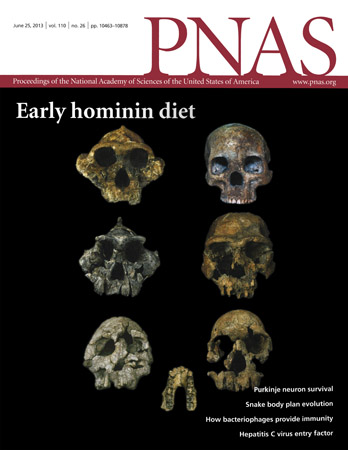
Biology Under Cover Abstract
Selected Journal & Book Covers from SBS Faculty
Thure Cerling, Kyalo Manthi, Emma Mbua, Louise Leakey, Meave Leakey, Richard Leakey, Francis Brown, Frederick Grine, John Hart, Prince Kaleme, Hélène Roche, Kevin Uno, and Bernard Wood. 2013.
Commentary
Hominin fossil evidence in the Turkana Basin in Kenya from ca. 4.1 to 1.4 Ma has two archaic early hominin genera and also records some of the early evolutionary history of Paranthropus (“Nutcracker Man”)and Homo. Stable carbon isotopes in fossil tooth enamel are used to estimate the fraction of diet derived from C3or C4resources in these hominin taxa. The earliest hominin species in the Turkana Basin, Australopithecus anamensis, derived nearly all of its diet from C3resources. Subsequently, by ca. 3.3 Ma, the later Kenyanthropus platyopshad a very wide dietary range—from virtually a purely C3resource-based diet to one dominated by C4resources. By ca. 2 Ma, hominins in the Turkana Basin had split into two distinct groups: specimens attributable to thegenus Homoprovide evidence for a diet with subequal amounts of C3-and C4-based resources, whereas Paranthropus boiseihad a higher fraction of C4-based diet (75 percent or higher). Homo sp. slightly increased the fraction of C4-based resources in the diet through in the next half-million years, and Paranthropus boiseimaintained its high dependency on C4-derived resources. Overall, this suggests that there was not dietary competition between Homoand Paranthropus.
Cover Image
This image is one of manyof the important hominin fossils discovered in the Turkana Basin.Pictured are hominin fossils from sites within the Turkana Basin in Kenya. Four articles in the Early Hominin Diet Special Feature illustrate how stable carbon isotopes present in the dental enamel of such fossils can reveal the diets of hominins that lived in Africa between roughly 4.1 and 1.3 million years ago. The papers found evidence of a shift from a diet dominated by leaves and fruits from trees, shrubs, and bushes to one that featured an increased proportion derived from grasses or sedges. Clockwise beginning at the top left are crania fromParanthropus boisei,Homo sapiensfrom the Holocene,Homo ergaster,Homo rudolfensis,Kenyanthropus platyops,and Paranthropus aethiopicus. At thebottom is a single mandible fromAustralopithecus anamensis. See the Commentary by Richard G. Klein on pages10470–10472. Images courtesy of Mike Hettwer and Yang Deming (Copyright of the National Museums of Kenya, Nairobi, Kenya).
Abstract
Hominin fossil evidence in the Turkana Basin in Kenya fromca. 4.1 to 1.4 Ma samples two archaic early hominin genera and records some of the early evolutionary history ofParanthropusandHomo. Stable carbon isotopes in fossil tooth enamel are used to estimate the fraction of diet derived from C3or C4resources in these hominin taxa. The earliest hominin species in the Turkana Basin,Australopithecus anamensis, derived nearly all of its diet from C3resources. Subsequently, byca. 3.3 Ma, the laterKenyanthropus platyopshad a very wide dietary range—from virtually a purely C3resource-based diet to one dominated by C4resources. Byca. 2 Ma, hominins in the Turkana Basin had split into two distinct groups: specimens attributable to the genusHomoprovide evidence for a diet with aca. 65/35 ratio of C3-to C4-based resources, whereasP. boiseihad a higher fraction of C4-based diet (ca. 25/75 ratio).Homosp. increased the fraction of C4-based resources in the diet throughca. 1.5 Ma, whereasP. boiseimaintained its high dependency on C4-derived resources.
